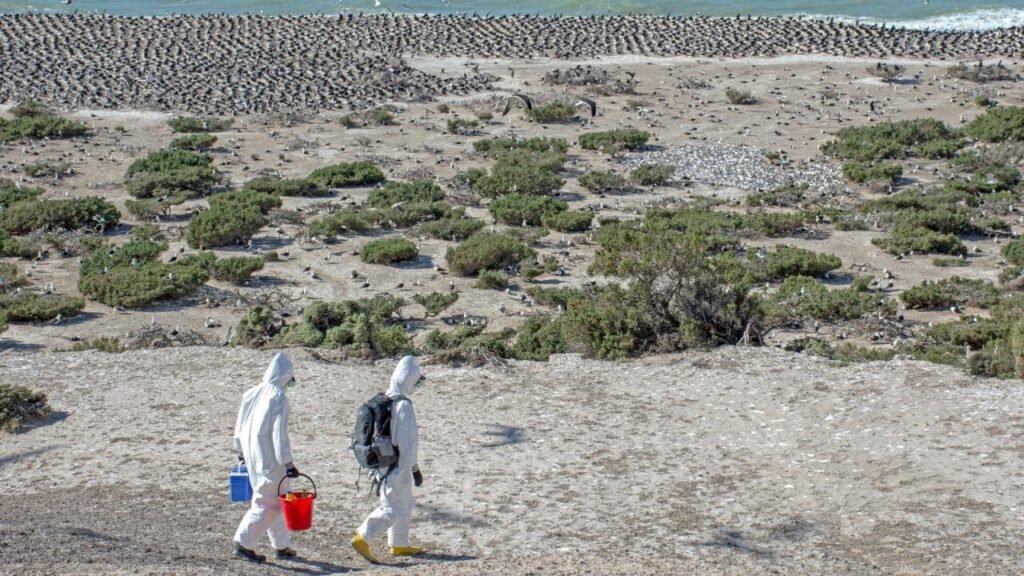× close
Luciana Gallo of BIOMAR-CONICET and Marcela Uhart of the University of California, Davis collected samples of the highly pathogenic H5N1 virus from cormorants (along the coast) and terns (in a green space) in Punta Leon, Argentina, in November 2023. A flock of terns subsequently died from the virus. Photo by Martin Brogger
Highly pathogenic H5N1 avian influenza viruses are becoming increasingly flexible and adapting to mammals in new ways, potentially with global implications for humans, wildlife and livestock, according to a new study into a possible large-scale epidemic among elephant seals in Argentina in 2023.
the study, Published as a preprint upon BioRxiv The study, co-led by the University of California, Davis School of Veterinary Medicine and Argentina’s National Institute of Agricultural Technology (INTA), found that the virus was transmitted from mammal to mammal. According to the study, this outbreak marks the first case of multinational transmission of a virus in mammals observed worldwide, with the same virus appearing in multiple pinniped species in multiple countries within a short period of time.
The study’s genomic analysis found that the virus evolved in separate lineages in birds and marine mammals in South America, which is unprecedented, raising concerns that H5N1 viruses adapted to infect mammals could potentially infect other species, including humans.
“This is further evidence that we need to be vigilant, especially with marine mammals,” said co-lead author Marcela Uhart, a veterinarian at the UC Davis Karen C. Dreyer Wildlife Health Center and Latin America Program. “The more adaptations we have in mammals, the more important they are to humans.”
An outbreak occurs
The current variant of H5N1 lineage 2.3.4.4b began causing problems on a global scale in 2020. As humanity was confronting the COVID-19 pandemic, H5N1, or “bird flu,” began killing tens of thousands of seabirds in Europe before moving to South Africa, entering the United States and Canada in 2022 and threatening poultry and wild birds, before spreading to South America in late 2022.
By February 2023, highly pathogenic avian influenza (HPAI) was detected for the first time in Argentina, affecting poultry primarily in the Argentine interior for five months. After two months without outbreaks in poultry, by August 2023, the virus was found in sea lions off the Atlantic coast of Tierra del Fuego, at the tip of South America. From there, the virus rapidly moved north, first with deadly consequences for marine mammals and then seabirds.
In October 2023, the outbreak in sea lions led the study authors to survey the elephant seal breeding colony in Punta Delgada, on the coast of Argentina’s Valdes Peninsula. They recorded an unprecedented mass mortality: about 17,000 elephant seals died. By November, 96% of the tern pups born that season had died. Testing confirmed the presence of HPAI H5N1 not only in the seals but also in several terns that had died during the same period.
× close
A healthy elephant seal. Nearly all of the seal pups born in Argentina’s Valdes Peninsula died from H5N1 during the fall 2023 breeding season. Photo by Valeria Falabella.
The virus split into avian and marine mammal lineages when H5N1 lineage 2.3.4.4b (specifically genotype B3.2) reached the continent through migratory birds and then infected mammals. It then separated from the avian lineage and became a unique virus adapted to marine mammals. The concern is that while the virus infects pinnipeds, it may also infect birds. This was evident in the study, where the virus found in terns was identical to that in elephant seals.
For more information:
Marcela Uhart et al., “Influenza A H5N1 outbreak in elephant seals in Peninsula Valdes, Argentina: increasing evidence of inter-mammal transmission” BioRxiv (2024). Publication date: 10.1101/2024.05.31.596774
